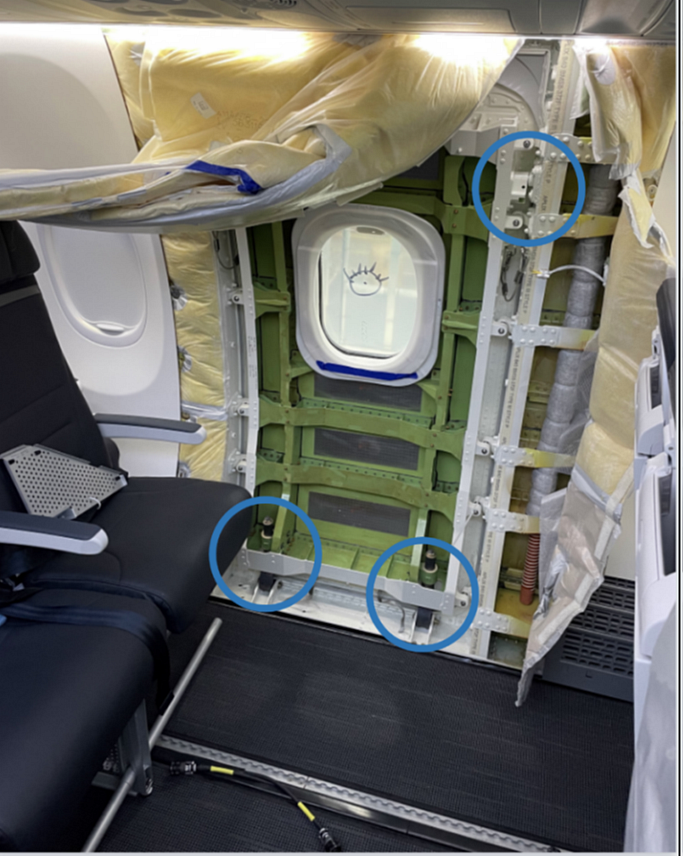Boeing 737 In Alaska Air Accident Was Missing Bolts, U.S. Says
The incident has become the biggest crisis for Boeing since its entire fleet of Max jets was grounded worldwide in 2019 following two fatal crashes.

(Bloomberg) -- Four bolts that should have prevented a panel from flying off an Alaska Airlines jet at 16,000 feet were apparently missing, US investigators said Tuesday, fueling more scrutiny about manufacturer Boeing Co.’s ability to ensure the safety of its planes.
Photos and other evidence suggest the bolts were removed for work at Boeing’s Renton, Washington, factory and not replaced, according to a preliminary 19-page report from the National Transportation Safety Board.
The incident has become the biggest crisis for Boeing since its entire fleet of Max jets was grounded worldwide in 2019 following two fatal crashes. Max 9 jets with the same configuration as the Alaska plane were grounded for weeks until they could be inspected, and regulators are poring over Boeing’s manufacturing processes and ratcheting up pressure on the company’s management.

The report reaches no conclusions about what caused the Jan. 5 accident, but it’s an unusually detailed account of the safety board’s initial fact-gathering. The independent agency can take a year or longer to reach a formal conclusion.
The findings point to “a breakdown in the quality management system within Boeing’s four walls,” said Melius Research analyst Rob Spingarn.
Boeing said it will review the report and continue to cooperate with US investigators.
“Whatever final conclusions are reached, Boeing is accountable for what happened,” Chief Executive Officer Dave Calhoun said in a statement. “We are implementing a comprehensive plan to strengthen quality and the confidence of our stakeholders.”
The US Federal Aviation Administration last month blocked Boeing from increasing 737 Max production as the agency reviews its quality practices. On Tuesday, key supplier Spirit AeroSystems Holdings Inc., which builds the 737 fuselages, declined to issue full-year guidance due to uncertainty over Boeing’s production rate.
Boeing shares rose 0.9% on Tuesday. The stock has fallen 20% since the beginning of the year. Spirit Aero gained 5%, paring its 2024 slump to about 12%.
The NTSB report shows that the day after arriving at Boeing’s Renton facility on Aug. 31, the 737 Max 9 airframe was flagged for having five damaged rivets along the side of the door plug where the failure later occurred. To replace those rivets, mechanics had to remove the door plug and four retaining bolts that hold it in place.
The rivets were replaced, according to a report by Spirit Aero personnel on Sept. 19. Afterward, a photo obtained by NTSB investigators showed the door plug missing retention bolts in at least three places. The photo was shared by Boeing employees before work on the plane’s interior, the report said.
In addition, the holes where the retention bolts would have been installed showed “no evidence of heavy contact damage,” the NTSB said. That suggests the bolts weren’t present when the panel blew open on the Alaska Air Group Inc. jet shortly after takeoff from Portland last month. The plane violently lost pressure and was forced to make an emergency landing. Seven passengers and a flight attendant reported minor injuries.
Bloomberg reported last month that two different record-keeping systems were used by Boeing to track work on 737s and that appears to have led to confusion at the Renton factory, according to people familiar with the incident. The NTSB report said the “investigation continues to determine what manufacturing documents were used to authorize the opening and closing” of the panel that failed.
Melius’ Spingarn said the report raises questions about why the plug was apparently not re-inspected to ensure the bolts were in place after the plug was removed and re-installed.
“In this instance, we seem to have multiple points of failure in that the bolts were not reinstalled, and then that mistake was not caught and corrected before the aircraft left the factory,” he said.
The FAA is conducting enhanced oversight of Boeing and Spirit. FAA Administrator Michael Whitaker on Tuesday told US House of Representatives lawmakers that the agency’s reviews are still underway, but so far it hadn’t found anything that would require “immediate action.” Initial findings may be released this month.

Issues with Boeing’s work on the Max family of aircraft continue to emerge. On Feb. 4, the company disclosed that it had learned of manufacturing flaws with rivet holes in about 50 undelivered 737s. The problem originated with Spirit, a spokesman for that company said.
It was the latest in a series of glitches originating with Boeing’s former aerostructures unit. A drilling mishap on an aft pressure bulkhead supplied by Spirit Aero slowed deliveries of the 737 Max last year, the planemaker’s most important generator of cash flow. A separate issue with tail-fin fittings affected output earlier in 2023.
The NTSB report shows “Boeing has serious work to do to rebuild its safety culture and the confidence of its customers and the flying public,” Representative Rick Larsen of Washington state, the highest ranking Democrat on the Transportation and Infrastructure Committee, said in a statement.
Senator Maria Cantwell, the Washington Democrat who chairs the Commerce Committee, said she would hold hearings on the issues raised by NTSB.
Boeing will also have to contend with the possibility of labor disruption later this year. Boeing’s largest union, the International Association of Machinists and Aerospace Workers, will demand a 40% pay raise over three or four years, emboldened by a resurgent US labor movement, a scarcity of qualified aerospace workers and pressure on Boeing to stabilize work in its factories.
--With assistance from Ari Natter and Lillianna Byington.
(Updates with analyst comment in fifth paragraph.)
More stories like this are available on bloomberg.com
©2024 Bloomberg L.P.